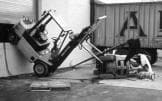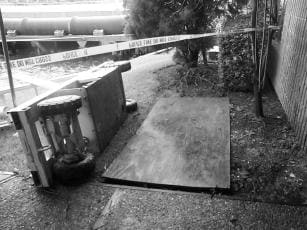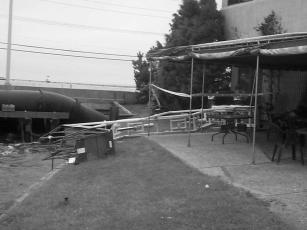Electrician Killed When Scissor Lift Tips Over in New Jersey
 |
 |
Fatality Assessment & Control Evaluation Project
FACE 00-NJ-073-01
July 19, 2001
On September 7, 2000, a 36-year-old electrician was killed when his scissor lift toppled over as he was preparing to install a light under a building soffit. The incident occurred at a bus terminal where the victim’s employer had been contracted to install 36 high-intensity lights around the perimeter of the two-story building. A crew of three workers was installing the last few lights in the rear of the building, located about 25 feet from the edge of a bay. Due to a large awning that covered an outdoor patio, the crew could not use their cherry-picker lift truck and instead used a battery-powered, hydraulic scissor lift to reach the soffit. Using a large sheet of plywood as a base on the ground, the crew positioned the lift near the side of the building. The supervisor raised the lift to test it before turning it over to the victim with his job instructions. At about 4:30 p.m. the victim’s co-worker was sawing wood on the ground below the lift when he heard the victim cry out and saw the lift fall over. The lift’s work platform crashed to the ground at the edge of the bay, throwing the victim headfirst into the shallow water. To prevent similar incidents in the future, NJ FACE recommends following these safety guidelines:
- Employers should ensure that personnel lifts are correctly used and positioned per manufacturer’s directions.
- Employers should conduct a job hazard analysis of all work tasks with the participation of the workers.
- Employers should ensure that scissor lift operators are properly trained.
INTRODUCTION
On September 13, 2000, NJ FACE personnel were notified by an OSHA safety supervisor of a work-related fatality involving a scissor lift that toppled over on August 7, 2000. FACE investigators contacted the OSHA compliance officer and arranged to conduct a concurrent investigation that was done on September 19, 2000. During the visit, FACE investigators interviewed the employer and witnesses to the incident. The incident site and scissor lift were also observed and photographed. Additional information on the incident was gathered from the OSHA compliance officer, the police report, and the medical examiner’s report.
The employer was a small, family-owned electrical contractor that specialized in both residential and commercial work. The owner had built up the business after taking it over from his father in 1974, eventually making his own son a full partner. At the time of the incident the company employed 14 workers (including three office staff) and owned ten trucks, including a “cherry- picker” lift truck. Employee training was “on-the-job,” and the company did not have any written health and safety programs. However, periodic safety meetings were conducted by their payroll company. The company was not unionized.
The victim was a 36-year-old male electrician who had worked for the company for about 18 months. He had four years of prior electrical experience and was said by the employer to be on his way to becoming a journeyman electrician. Company training included on-the-job training at work and coursework in electrical theory and codes taken at the local vocational-technical school.
INVESTIGATION
The incident occurred at an urban bus transportation terminal. This terminal was a closed service and rest facility that served the buses and drivers that ran through the area. The terminal’s management had hired the electrical contractor to install decorative lights around the grounds of the terminal to highlight the landscaping. Thirty-six lights were also to be installed in the overhanging roof eve (soffit) to highlight the perimeter of the main terminal building. Work started on the project in May 2000, with the contractor first installing the ground lights and underground wiring. Bad weather and problems with obtaining the proper blueprints and permits caused the project to be delayed through the summer. Once the problems were resolved, the company completed most of the groundwork and started installing lights on the terminal building.
The incident occurred on Thursday, September 7, 2000. A crew of three workers was assigned to finish installing the last few lights on the terminal building. The crew included a foreman, an electrician (the victim), and an electrician’s helper. The foreman and helper arrived at the site at 9:00 a.m., with the victim arriving later at 10:30. During the morning, the crew completed work on one side of the building and prepared to work at the rear of the building near the cafeteria. Adjoining the cafeteria was an outdoor concrete patio area covered by a large awning. About 28 feet from the rear of the building and five feet from the patio deck was a salt-water bay, its edge made up of a bulkhead (retaining wall) of stacked timbers (see photo). The crew had used the cherry-picker truck to reach the 25 foot-high soffit on the other parts of the building, but the awning blocked the truck from driving onto the patio. Anticipating this problem, the contractor brought a battery-powered, hydraulic scissor lift that was small enough to enter the area. This lift had a 20 foot-high reach and an 8 foot-long, 28 inch-wide work platform equipped with safety rails. The platform could be extended an additional 3 feet, for a total length of 11 feet.
Shortly after lunch, the foreman drove the lift around the building and set it up near the corner of the building beside the patio. Since the awning prevented the lift from being set up on the cement patio deck, the crew decided to use a sheet of plywood on the ground as a base for the lift. After leveling the dirt and mulch with their feet, they put down a single four by eight-foot sheet of ¾-inch plywood and positioned the lift on it. The foreman then raised the lift to test it. Seeing it was ok, the foreman rode up on the lift with the victim and noticed some branches from a tree were getting in the way, which they removed. The foreman then went to work on the other side of the building, leaving the victim and helper to their jobs.
The afternoon passed uneventfully. The foreman twice checked on the workers and asked if they needed any help, which they did not. The victim came down from the lift three times, once going over to the foreman to ask a question. Shortly before 3:45 p.m., he came down for the last time to get a drill from the helper. After again raising the lift, the helper saw the victim sitting on the top guardrail of the lift platform, his legs wrapped around the bottom rails for support. The helper also saw that he was wearing personal stereo headphones as he worked. A few minutes later, while the helper was sawing a board near the bottom of the lift, he heard the victim cry out. The helper looked up and saw the lift tipping over. The lift platform landed just beyond the edge of the bulkhead, throwing the victim headfirst into the four to five foot deep tidal bay. The helper, who could not swim, jumped into the water but could not reach the victim. He climbed out of the water and went for the foreman as patrons from the cafeteria came to help. The foreman ran back to see the victim being pulled out of the water and a bus driver with EMT training start to work on him. The police and paramedics arrived and found that the victim had a pulse but was unresponsive. He was transported to the local hospital where he died of head and neck injuries at 6:46 p.m.
 |
 |
| Photo 1. Plywood base on mulch | Photo 2. Lift platform on bay bulkhead |
It appears that several factors may have contributed to this incident. The scissor lift was designed for indoor use and was equipped with a safety device that activated a warning buzzer and light when the lift tilted beyond a pre-set limit of three degrees side-to-side or five degrees front-to-back. The Federal OSHA investigator measured the pitch of the plywood at eight degrees to the side. It appears that the dirt and mulch under the plywood compacted unevenly under the weight of the 3,000-pound lift, causing it to lean off center. The victim was also seen sitting on the safety rails, which could throw the lift further off balance. There is also the possibility of the victim pushing against the wall of the building as the worked from the lift. Witnesses stated the lift’s warning buzzer was working that day, however, no one heard the alarm prior to the incident. Witnesses observed that the victim was wearing headphones that may have prevented him from hearing the alarm.
RECOMMENDATIONS/DISCUSIONS
Recommendation #1: Employers should ensure that personnel lifts are correctly used and positioned per manufacturer’s directions.
Discussion: The lift used in the incident was primarily designed for indoor use on hard, level surfaces. The victim was also sitting on the rails. FACE recommends that industrial lifts should be used as per the manufacturer’s design and directions. If there is a question about proper use, the manufacturer or sales representative should be consulted. In this case, an all-terrain personnel lift would have been appropriate.
Recommendation #2: Employers should conduct a job hazard analysis of all work tasks with the participation of the workers.
Discussion: In this incident, the electrical contractor did not have the proper equipment to do the job safely (see recommendation #1). FACE recommends that employers and workers should first conduct a job hazard analysis of the work area before starting a job. A job hazard analysis should begin by reviewing the tasks of each worker and the equipment needed. Each task is examined for fall, electrical, chemical, environmental, or other hazards that the worker may encounter. Afterwards, appropriate controls and safety training can be used to eliminate the hazards. More information can be found in the attached OSHA publication, Job Hazard Analysis.
Recommendation #3: Employers should ensure that scissor lift operators are properly trained.
Discussion: FACE recommends that all personnel lift operators be properly trained in the use and safe work practices of the equipment. Although scissor and other personnel lifts are not covered under the OSHA powered industrial truck regulation, FACE recommends using this standard as a training model for this type of equipment. Employers should provide classroom and hands-on training to the operators, and training must be specific to the worksite and equipment used. Training must be taught by a competent person, and operators should be certified as having passed the training. Lift operators should be periodically reevaluated afterwards. The complete OSHA powered industrial truck standard 29 CFR 1910.178 and information on other OSHA regulations are available from the following sources:
U.S. Department of Labor, OSHA
On request, OSHA will provide information on safety and health standards. OSHA has several offices in New Jersey that cover the following areas:
Hunterdon, Middlesex, Somerset, Union, and Warren Counties………………..(732) 750-4737
Essex, Hudson, Morris, and Sussex counties…………………………………………(973) 263-1003
Bergen and Passaic counties……………………………………………………………….(201) 288-1700
Atlantic, Burlington, Cape May, Camden, Cumberland, Gloucester,
Mercer, Monmouth, Ocean, and Salem counties…………………………………….(609) 757-5181
NJ Public Employees Occupational Safety and Health (PEOSH) Program
The PEOSH act covers all NJ state, county, and municipal employees. The act is administered by two departments; the NJ Department of Labor (NJDOL) which investigates safety hazards, and the NJ Department of Health and Senior Services (NJDHSS) which investigates health hazards. Their telephone numbers are:
NJDOL, Office of Public Employees Safety ………………………………………….(609) 633-3896
NJDHSS, PEOSH Program……………………………………………………………….(609) 984-1863
NJDOL Occupational Safety and Health On-Site Consultative Program
Located in the NJ Department of Labor, this program provides free advice to private businesses on improving safety and health in the workplace and complying with OSHA standards. For information regarding a safety consultation, call (609) 292-0404, for a health consultation call (609) 984-0785. Requests may also be faxed to (609) 292-4409.
New Jersey State Safety Council
The NJ Safety Council provides a variety of courses on work-related safety. There is a charge for the seminars. Their address and telephone number is: NJ State Safety Council, 6 Commerce Drive, Cranford, NJ 07016. Telephone (908) 272-7712
Internet Resources
Information and publications on safety and health standards can be easily obtained over the internet. Some useful sites include:
www.osha.gov – The US Department of Labor OSHA website, which include all OSHA regs.
www.cdc.gov/niosh/ – The CDC/NIOSH website.
www.state.nj.us/health/eoh/peoshweb/ – The NJDHSS PEOSH website.
www.dol.gov/elaws/ – USDOL Employment Laws Assistance for Workers and Small Businesses
ATTACHMENTS
Job Hazard Analysis. OSHA 3071, US Department of Labor, Occupational Safety and Health Administration, Washington DC. 1998. Available online: https://www.osha.gov/Publications/osha3071.pdf (Link updated 11/15/2006)
Fatality Assessment and Control Evaluation (FACE) Project
Investigation # 00-NJ-073-01
Staff members of the New Jersey Department of Health and Senior Services, Occupational Health Service, perform FACE investigations when there is a report of a targeted work-related fatal injury. The goal of the FACE Program is to prevent future incidents by studying and identifying the risk factors that contribute to workplace fatalities, by recommending intervention strategies, and by disseminating information to employers and employees. NJ FACE data is reported to NIOSH for trend analysis on a national basis. All identifiers are removed from the FACE reports and other data to protect the confidentiality of those who participate in the program.
NIOSH funded state-based FACE Programs include: Alaska, California, Iowa, Kentucky, Massachusetts, Minnesota, Missouri, Nebraska, New Jersey, Ohio, Oklahoma, Texas, Washington, West Virginia, and Wisconsin.
To contact New Jersey State FACE program personnel regarding State-based FACE reports, please use information listed on the Contact Sheet on the NIOSH FACE web site. Please contact In-house FACE program personnel regarding In-house FACE reports and to gain assistance when State-FACE program personnel cannot be reached.
Back to New Jersey FACE reports
Back to NIOSH FACE Web
